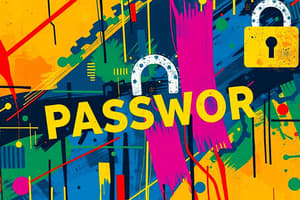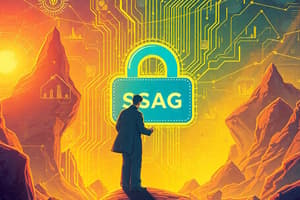Podcast
Questions and Answers
Which action is LEAST effective in maintaining strong password security?
Which action is LEAST effective in maintaining strong password security?
- Avoiding the use of common password patterns.
- Using a combination of upper and lower case letters, numbers, and special characters.
- Employing easily memorable personal information, such as your pet's name and birthdate. (correct)
- Enabling two-factor authentication (2FA) wherever possible.
Which of the following file formats is commonly associated with word processing documents?
Which of the following file formats is commonly associated with word processing documents?
- .jpg
- .doc (correct)
- .exe
What is the primary function of a firewall in cybersecurity?
What is the primary function of a firewall in cybersecurity?
- Providing cloud storage and backup services.
- Blocking unauthorized access to a network. (correct)
- Scanning computers for existing malware and removing it.
- Encrypting all outgoing network traffic for enhanced privacy.
Which scenario poses the GREATEST risk to your online safety?
Which scenario poses the GREATEST risk to your online safety?
A user reports that their files are missing after saving them to cloud storage. After confirming the files were successfully uploaded, which of the following scenarios is MOST likely the reason they cannot locate the files on their computer, assuming no user error?
A user reports that their files are missing after saving them to cloud storage. After confirming the files were successfully uploaded, which of the following scenarios is MOST likely the reason they cannot locate the files on their computer, assuming no user error?
Flashcards
Strong Password
Strong Password
A mix of letters, numbers, and symbols used to protect accounts.
Firewall
Firewall
Software that blocks unauthorized access to your network.
Malware
Malware
Malicious software, such as viruses, worms, and spyware, that can harm your computer.
Cloud Storage
Cloud Storage
Signup and view all the flashcards
Keyboard Shortcuts
Keyboard Shortcuts
Signup and view all the flashcards
Study Notes
- Public Wi-Fi is unsafe without a VPN
Password Security
- Use strong passwords with a mix of letters, numbers, and special characters
- Avoid common passwords such as "123456" and birth dates
- Enable two-factor authentication (2FA) for added security
File Formats
- Word processing documents use the ".doc" file extension
- Images commonly use the ".jpg" file extension
- A common format for downloads is ".pdf"
Online Safety
- Never share passwords with anyone
- Avoid clicking on unknown or suspicious links
- Exercise caution with email attachments from unknown senders
Operating Systems vs. Software
- Operating Systems: Windows, Linux, macOS
Cybersecurity Basics
- Firewalls block unauthorized network access
- Malware includes viruses, worms, and spyware
Cloud Storage
- Cloud storage saves files online, not on your local hard drive
- Examples of cloud storage: Google Drive, OneDrive, Dropbox
- Not cloud storage: Microsoft Word, Photoshop, Firefox
Safe Software Downloading
- Verify the software source and check reviews before downloading
- Keep antivirus software enabled
- Avoid sharing unverified download links
Web Browsers
- Web Browsers: Google Chrome, Mozilla Firefox, Microsoft Edge
Keyboard Shortcuts
- Paste: Ctrl + V
- Copy: Ctrl + C
- Cut: Ctrl + X
- Bold Text: Ctrl + B
- Print: Ctrl + P
Studying That Suits You
Use AI to generate personalized quizzes and flashcards to suit your learning preferences.




